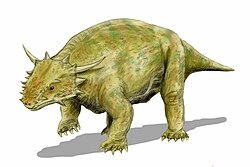| Acleistorhinidae Temporal range: Late Carboniferous and Early Permian, | |
|---|---|
 | |
| Skull reconstruction of Colobomycter pholeter | |
| Scientific classification | |
| Kingdom: | Animalia |
| Phylum: | Chordata |
| Class: | Reptilia |
| Subclass: | † Parareptilia |
| Order: | † Procolophonomorpha |
| Superfamily: | † Lanthanosuchoidea |
| Family: | † Acleistorhinidae Daly, 1969 [1] |
| Genera | |
| |
Acleistorhinidae is an extinct family of Late Carboniferous and Early Permian-aged (Moscovian to Kungurian stage) parareptiles. It is defined as a node based clade including the last common ancestor of Acleistorhinus pteroticus and Colobomycter pholeter and all its descendants. [2] Acleistorhinids are most diverse from the Richards Spur locality of the Early Permian of Oklahoma. Richards Spur acleistorhinids include Acleistorhinus , Colobomycter , Delorhynchus , Feeserpeton and Klastomycter . [3] Other taxa include Carbonodraco from the Late Carboniferous of Ohio [4] and Karutia from the Early Permian of Brazil. [5] Acleistorhinidae is commonly considered a subgroup of lanthanosuchoids, related to taxa such as Chalcosaurus , Lanthaniscus and Lanthanosuchus . [6] However, a re-examination of parareptile phylogeny conducted by Cisneros et al. (2021) argued that lanthanosuchids were not closely related to acleistorhinids. The phylogenetic analysis conducted by these authors recovered acleistorhinids as the sister group of the clade Procolophonia, while lanthanosuchids were recovered within the procolophonian subgroup Pareiasauromorpha. [5]
Acleistorhinidae is notable for being the oldest-known parareptilian clade. The family is diagnosed by the presence two synapomorphies: (1) the largest tooth is located far anteriorly on the maxilla; and (2) cranial ornamentation consists of sparse and shallow circular dimples. [2]






